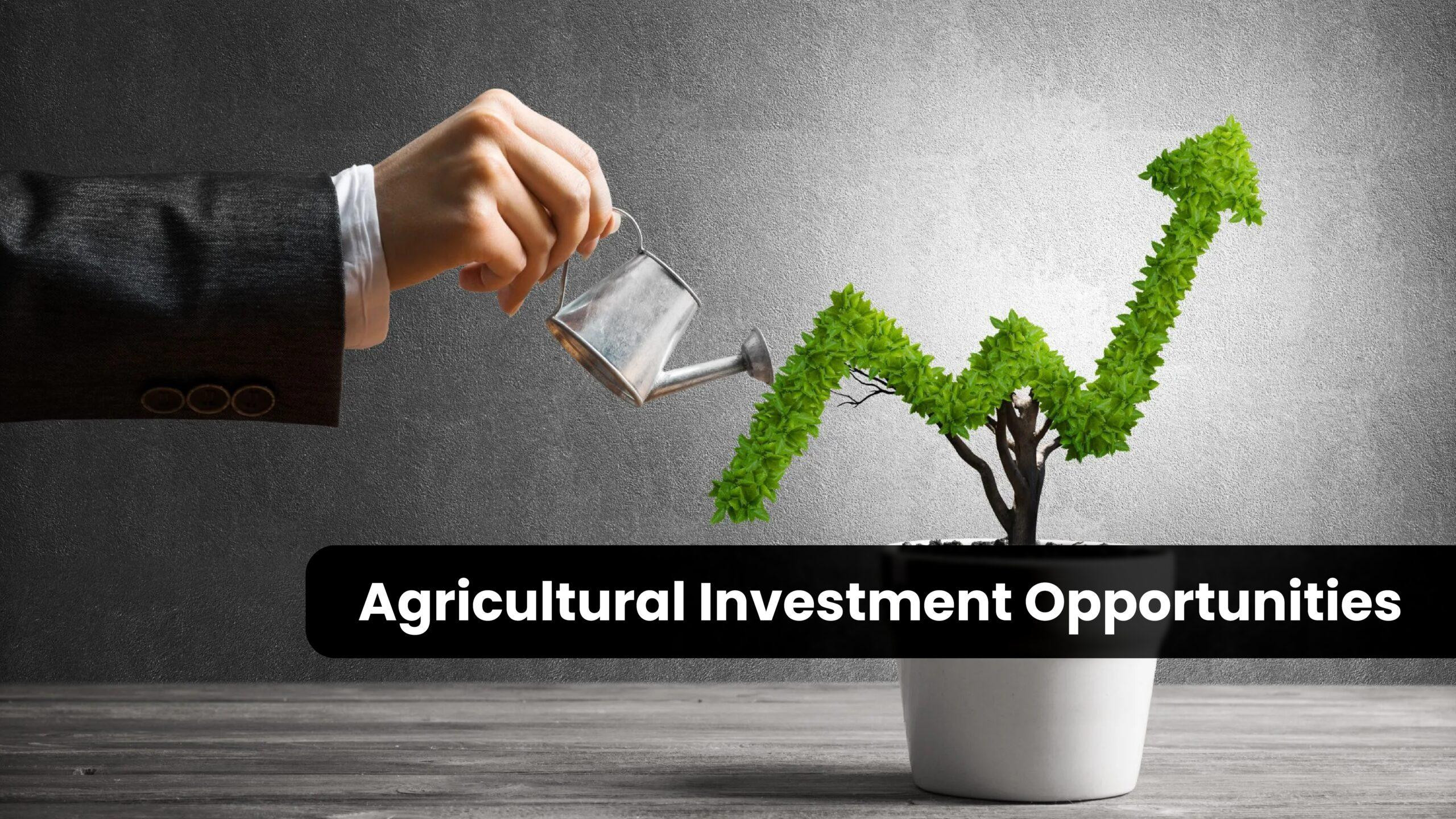
Agriculture Investment
Agriculture investment involves putting resources into various agricultural assets or projects with the expectation of generating financial returns. This sector is essential to the global economy, and it offers a variety of opportunities, from investing in farmland to agricultural technology and commodity markets. Agriculture investments can be attractive due to their potential for steady income, growth, and resilience, even in economic downturns. Here's a comprehensive look at agriculture investment:
Why Invest in Agriculture?
- Growing Global Demand: The world's population continues to rise, projected to reach 9.7 billion by 2050, significantly increasing demand for food, fiber, and fuel.
- Inflation Hedge: Agricultural commodities often serve as a hedge against inflation since their prices generally rise with increased consumer demand and economic growth.
- Portfolio Diversification: Agricultural investments have a low correlation with traditional assets like stocks and bonds, offering diversification benefits.
- Impact and Sustainability: Investors can contribute to sustainable agriculture, food security, and environmental conservation, appealing to those interested in impact investing.
Types of Agriculture Investments
Farmland: Owning farmland can provide income from leasing to farmers or generating yields from crop production. Farmland values have appreciated historically, making it a reliable asset that generates both rental income and capital appreciation over time.
Agricultural Real Estate Investment Trusts (REITs): Agricultural REITs allow investors to buy shares in companies that own farmland, storage facilities, and other infrastructure needed for farming. Examples include Farmland Partners and Gladstone Land.
Commodities and Futures: Agricultural commodities include grains (like wheat, corn), livestock (cattle, hogs), and soft commodities (coffee, cocoa). Futures contracts allow investors to bet on the price movements of these commodities, but they are speculative and require a deep understanding of the market.
Agribusiness Stocks: Investing in companies involved in agriculture (e.g., John Deere, Archer Daniels Midland, Bayer) provides exposure to the sector through shares of companies in equipment manufacturing, chemicals, seeds, and food production.
Agricultural Technology (AgTech): The AgTech sector includes innovations that improve agricultural productivity and sustainability, like precision farming, drones, data analytics, and genetic modification. AgTech companies aim to optimize resource use, increase yield, and make farming more resilient to climate change.
Agricultural Funds: Mutual funds and ETFs focused on agriculture provide diversified exposure to multiple assets within the sector. These funds may include farmland, agribusinesses, commodities, and AgTech companies.
Sustainable and Regenerative Agriculture Funds: Sustainable agriculture funds focus on environmentally friendly farming practices, such as regenerative agriculture, organic farming, and carbon capture. These funds align with ESG (environmental, social, and governance) principles.
Factors Affecting Agriculture Investments
Climate and Weather Patterns: Agriculture is heavily affected by weather conditions and climate change. Droughts, floods, and extreme temperatures can impact crop yields and livestock health, affecting returns on agriculture investments.
Supply and Demand Dynamics: Supply chain disruptions, changes in consumer preferences, and economic cycles impact the supply and demand of agricultural products, influencing prices.
Technological Advancements: Innovations in farming, data analytics, genetics, and equipment improve productivity, reduce costs, and expand yield capacity, increasing the profitability of agricultural investments.
Government Policies and Subsidies: Governments often support farmers with subsidies, tariffs, or other policies, especially in critical crops like corn, wheat, and soybeans. Policy changes can have positive or negative effects on the profitability of agriculture investments.
Global Trade Agreements: Trade agreements, tariffs, and export bans can impact prices and accessibility of certain agricultural products, especially in international commodity markets.
Benefits of Agriculture Investment
Stable Income and Capital Appreciation: Farmland investments provide both income (from leases or crop yields) and the potential for long-term value appreciation, making them attractive to income-focused investors.
Inflation Protection: Agricultural commodities and farmland often increase in value with inflation, allowing investors to preserve purchasing power.
Sustainability and ESG Alignment: Agriculture investments in sustainable farming and AgTech align with ESG values, helping reduce environmental impact, enhance food security, and promote social equity.
Resilience in Economic Downturns: Agriculture, particularly farmland, has shown resilience in recessions and downturns, as people always need food regardless of the economic climate.
Risks in Agriculture Investment
Climate Risk and Natural Disasters: Crop failures, pests, disease, and unpredictable weather patterns can impact agriculture investments significantly.
Price Volatility: Agricultural commodity prices are often volatile, fluctuating due to supply, demand, and geopolitical factors. This volatility can impact income and returns.
Operational Risk in Farmland Ownership: Farmland ownership requires knowledge of agricultural practices, crop cycles, and land management. Investors may face operational challenges if they are not well-versed in farming.
Geopolitical and Trade Risks: Agriculture is sensitive to trade policies, export restrictions, and international relations, impacting profitability in global markets.
Market Risks in AgTech Investments: Investing in AgTech involves risks common in tech sectors, including rapid innovation cycles, potential regulatory hurdles, and high competition.
Agriculture Investment Strategies
Buy and Hold (Long-Term Investment): Farmland and agricultural REITs are often viewed as long-term assets due to their income-generating potential and value appreciation over time.
Value Investing in Agribusiness Stocks: Some investors look for undervalued agribusiness companies that may have growth potential due to new product developments or expansion into emerging markets.
Sustainable and Impact Investing: Investors focused on ESG principles may prioritize investments in sustainable agriculture or regenerative farming that support long-term environmental health and resource efficiency.
Commodity and Futures Trading: Experienced investors can trade agricultural commodities through futures and options, although this is a more speculative and volatile area of agriculture investment.
Diversification with Agricultural Funds: Investing in mutual funds or ETFs focused on agriculture provides diversified exposure to various aspects of the sector, reducing individual asset risk.
Trends and the Future of Agriculture Investment
Rise of AgTech and Smart Farming: Technology in agriculture, such as precision farming, IoT (Internet of Things) devices, and drones, is transforming productivity and resource efficiency. The global AgTech market is expected to grow significantly as farms adapt to modern, data-driven methods.
Sustainability and Climate-Smart Agriculture: Sustainable agriculture practices, such as regenerative farming, are gaining traction. Investors increasingly support initiatives that reduce greenhouse gas emissions, promote biodiversity, and enhance soil health.
Farmland as a Finite Resource: With urbanization and soil degradation reducing available farmland, the value of arable land may increase as demand rises, benefiting farmland investors.
Global Food Security Concerns: As food security becomes a more pressing issue globally, investment in agricultural supply chains, storage, and logistics infrastructure is also increasing to support a stable and secure food system.
Conclusion
Agriculture investment offers a range of options from farmland ownership and commodity trading to AgTech innovation and sustainable funds. It provides opportunities for income generation, portfolio diversification, and long-term growth potential. However, like any investment, it carries risks, particularly from weather, price volatility, and market challenges. With trends such as rising demand for sustainable farming and advances in agricultural technology, agriculture investment is positioned as both a resilient and potentially impactful sector for investors looking to diversify and contribute to global food security and environmental sustainability.
All comments
Comment not found




